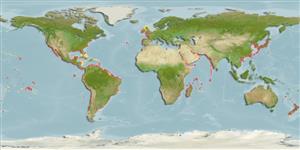Neanthes succinea (Frey & Leuckart, 1847)
Clam worm| Native range | All suitable habitat | Point map | Year 2050 |

|
| This map was computer-generated and has not yet been reviewed. |
| Neanthes succinea AquaMaps Data sources: GBIF OBIS |
Upload your photos
Google image |
No photo available for this species.No drawings available for Nereididae.
Google image |
No photo available for this species.
Classification / Names Κοινά ονόματα | Συνώνυμα | CoL | ITIS | WoRMS
Polychaeta | Phyllodocida | Nereididae
Environment: milieu / climate zone / εύρος βάθους / distribution range Οικολογία
; εύρος βάθους 0 - 12 m (Αναφ. 107206). Tropical
Distribution Χώρες | Περιοχές FAO | Οικοσυστήματα | Παρουσίες | Εισαγωγές
Indo-Pacific and Atlantic Ocean.
Length at first maturity / Μέγεθος / Weight / Age
Γεννητική Ωρίμανση: Lm ? range ? - ? cm
Lives in shallow waters (Ref. 107206). Infaunal (Ref. 107205) and epifaunal (Ref. 108785), non-selective surface deposit feeder (Ref. 107205). Estuarine euryhaline opportunistic species. Inhabits intertidal mudflats, also in a variety of habitats such as crevices between oyster shells, among barnacles, associated with mussels and sponge masses (Ref. 108785).
Life cycle and mating behavior Γεννητική Ωρίμανση | Αναπαραγωγή | Γεννοβολία | Eggs | Γονιμότητα | Larvae
Members of the class Polychaeta are mostly gonochoric (sexual). Mating: Females produce a pheromone attracting and signalling the males to shed sperm which in turn stimulates females to shed eggs, this behavior is known as swarming. Gametes are spawned through the metanephridia or body wall rupturing (termed as "epitoky", wherein a pelagic, reproductive individual, "epitoke", is formed from a benthic, nonreproductive individual, "atoke"). After fertilization, most eggs become planktonic; although some are retained in the worm tubes or burrowed in jelly masses attached to the tubes (egg brooders). Life Cycle: Eggs develop into trocophore larva, which later metamorph into juvenile stage (body lengthened), and later develop into adults.
Main reference
Αναφορές | Συντονιστής | Συνεργάτες
MarineSpecies.org. 2050. (Αναφ. 3477)
IUCN Red List Status
(Αναφ. 130435: Version 2024-2)
CITES status (Αναφ. 108899)
Not Evaluated
CMS (Αναφ. 116361)
Not Evaluated
Threat to humans
Human uses
| FishSource |
Εργαλεία
Περισσότερες πληροφορίες
Τροφική Οικολογία
Οικολογία
Population dynamics
Αύξηση
Max. ages / sizes
Length-weight rel.
Length-length rel.
Length-frequencies
Mass conversion
Στρατολόγηση
Αφθονία
Max. ages / sizes
Length-weight rel.
Length-length rel.
Length-frequencies
Mass conversion
Στρατολόγηση
Αφθονία
Life cycle
Distribution
Human Related
Aquaculture profiles
Stamps, coins, misc.
Stamps, coins, misc.
Outreach
Taxonomy
Αναφορές
Διαδικτυακές πηγές
BHL | BOLD Systems | CISTI | DiscoverLife | FAO(Publication : search) | Fishipedia | GenBank (genome, nucleotide) | GloBI | 1 GoMexSI (interaction data) | Google Books | Google Scholar | Google | PubMed | Δέντρο Ζωής | Wikipedia (Go, αναζήτηση) | Zoological Record
Estimates based on models
Preferred temperature
(Ref. 115969): 12.8 - 28.3, mean 26.5 (based on 1793 cells).
Price category
(Αναφ. 80766):
Unknown.


